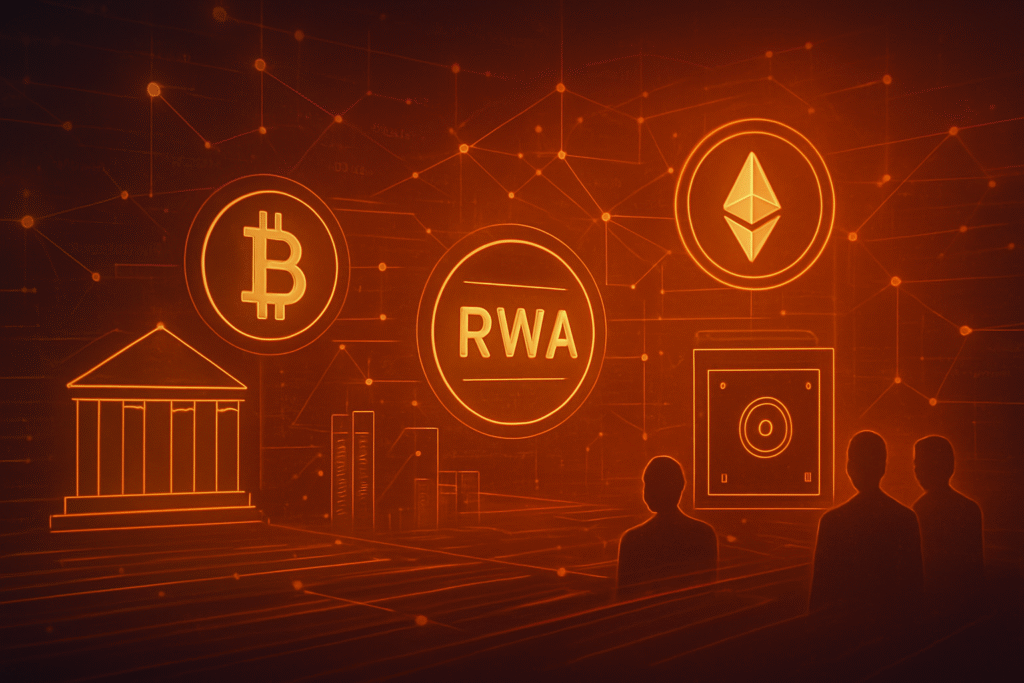
The Decentralized Finance (DeFi) ecosystem is undergoing an unprecedented transformation as of November 2025, marked by a surge of innovations poised to fundamentally reshape traditional finance. At the forefront of this evolution is the burgeoning trend of Real-World Asset (RWA) tokenization, which is rapidly bridging the chasm between conventional financial systems and the decentralized world. This paradigm shift, coupled with increasing institutional adoption and significant advancements in scalability and user experience, signals a maturation of DeFi, moving beyond its speculative origins towards a more integrated and impactful role in the global economy.
The immediate market reaction has been one of cautious optimism, with a notable uptick in interest and investment flowing into protocols at the intersection of TradFi and DeFi. The expansion of the RWA market, which has grown nearly five-fold in three years to approximately $24 billion by mid-2025, underscores the tangible value proposition these innovations bring. This period marks a critical juncture where DeFi's promise of efficiency, transparency, and accessibility is beginning to materialize into concrete applications, attracting a broader spectrum of participants and setting the stage for a new era of financial services.
Market Impact and Price Action
The latest wave of DeFi innovations, particularly the robust growth in Real-World Asset (RWA) tokenization and the increasing institutional engagement, has instilled a renewed sense of confidence within the cryptocurrency market. While specific token price movements can be volatile, the overarching sentiment for DeFi-related assets has been positive. Tokens associated with protocols actively developing RWA solutions, institutional-grade DeFi platforms, and advanced Layer-2 scaling solutions have generally seen increased investor interest and trading volume. This reflects the market's recognition of the long-term value proposition these developments offer in integrating DeFi with traditional finance.
The influx of capital into the RWA sector, projected to reach $2 trillion by 2028, has naturally led to enhanced liquidity for related assets and platforms. New financial products emerging from this trend, such as tokenized bonds, real estate, and private credit, are creating novel yield-generating opportunities that appeal to a wider investor base, including institutional players. This diversification of investment avenues within DeFi is contributing to a more resilient and less speculative market environment.
From a technical analysis perspective, the broader DeFi market appears to be establishing stronger support levels, driven by fundamental utility rather than purely speculative fervor. Resistance levels are being tested as institutional capital gradually makes its way into the ecosystem, often through permissioned DeFi models and compliant frameworks. This current phase draws parallels to earlier DeFi booms, but with a crucial difference: the emphasis is now firmly on sustainable growth, regulatory compliance, and tangible integration with real-world economic activities, suggesting a more enduring market impact than previous cycles.
Community and Ecosystem Response
The crypto community has met these developments with significant enthusiasm, particularly around the potential of Real-World Asset (RWA) tokenization. Discussions across social media platforms like X (formerly Twitter) and Reddit are buzzing with excitement over the prospect of unlocking trillions in illiquid assets and making high-value investments accessible to a global audience. Crypto influencers and thought leaders are largely championing RWAs as the next major catalyst for DeFi adoption, highlighting projects like Centrifuge and MakerDAO's (MKR) increasing reliance on RWA collateral as proof of concept.
Beyond RWAs, the community is also keenly following advancements in scalability and user experience. Vitalik Buterin's endorsement of ZKsync's Atlas upgrade in November 2025, promising over 15,000 transactions per second (TPS) with near-zero fees, has generated considerable excitement about Ethereum's (ETH) future. The push for smart wallets and account abstraction (ERC-4337) is also widely celebrated as a critical step towards making DeFi more intuitive and accessible for mainstream users, reducing the often-steep learning curve.
The broader Web3 ecosystem is also responding by integrating these innovations. NFT projects are exploring RWA applications, such as fractionalized ownership of physical art or real estate. Related DeFi protocols are adapting to offer new lending and borrowing opportunities against tokenized assets. There's a strong sentiment that compliance and security, once seen as hindrances, are now becoming "brand assets" for successful protocols, driving a collective effort to enhance security audits, implement emergency governance protocols, and develop robust DeFi insurance options to build user trust and attract institutional capital.
What's Next for Crypto
The short-term implications for the crypto market are likely to involve continued growth in the RWA sector, with more traditional financial institutions (TradFi) exploring and implementing tokenization solutions. This will likely lead to increased liquidity and diversification within DeFi, making it a more attractive proposition for a wider range of investors. In the long term, these innovations are paving the way for a truly integrated global financial system where the efficiencies of blockchain technology underpin both traditional and decentralized markets.
Potential catalysts to watch include the full implementation of regulatory frameworks like the EU's MiCA, which, while creating initial hurdles, will ultimately provide clarity and confidence for institutional participation. Further advancements in Layer-2 scaling solutions and cross-chain interoperability, such as the ongoing developments in sharding for Ethereum and new protocols like Kyo Finance consolidating liquidity, will be crucial for handling increased transaction volumes and fostering a seamless multi-chain environment. The growing synergy between AI and DeFi, enhancing security, risk management, and personalized user experiences, also represents a significant development to monitor.
Strategic considerations for projects and investors should focus on protocols that prioritize security, regulatory compliance, and tangible utility through RWA integration. Projects that can effectively bridge the gap between TradFi and DeFi, offering permissioned access and robust KYC/AML frameworks, are well-positioned for success. Investors should look for opportunities in established RWA protocols, innovative Layer-2 solutions, and projects leveraging AI for enhanced DeFi functionality. Possible scenarios include a rapid acceleration of institutional DeFi adoption, leading to a significant expansion of the overall crypto market capitalization, or a more gradual, but steady, integration as regulatory clarity solidifies globally.
Bottom Line
The current wave of innovation within the Decentralized Finance (DeFi) ecosystem marks a pivotal moment, signaling its maturation and increasing integration with traditional finance. The tokenization of Real-World Assets (RWAs) stands out as a key driver, transforming illiquid assets into accessible, transparent, and globally tradable digital tokens. This trend, combined with growing institutional interest and significant technological advancements in scalability, user experience, and security, is fundamentally reshaping how financial services are delivered and consumed.
For crypto investors and enthusiasts, the key takeaway is the shift from purely speculative plays to value-driven investments underpinned by real-world utility and institutional participation. The long-term significance of these developments lies in DeFi's potential to create a more efficient, inclusive, and transparent global financial system. As regulatory frameworks evolve and technology continues to advance, DeFi is poised to become an increasingly integral component of the financial landscape, offering unparalleled opportunities for innovation and economic growth.
Important metrics to monitor include the continued growth of the RWA market, the adoption rate of institutional DeFi solutions, and the progress of Layer-2 scaling technologies. Upcoming events, such as the full implementation of global crypto regulations and further upgrades to major blockchain networks like Ethereum, will also be critical indicators of DeFi's trajectory. This period represents a compelling opportunity for those who understand the evolving dynamics of decentralized finance and its profound implications for the future of money.
This article is for informational purposes only and does not constitute financial or investment advice. Cryptocurrency investments carry significant risk.




